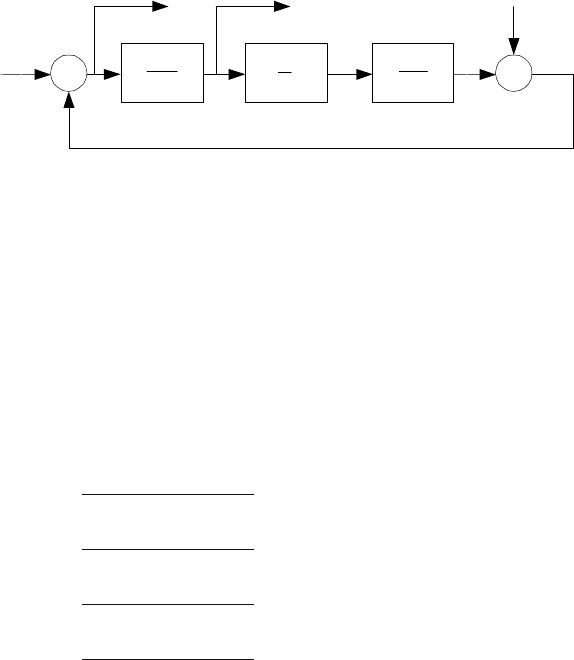Mikles J., Fikar M. Process Modelling, Identification, and Control
Подождите немного. Документ загружается.


8.6 Analysis of State Feedback with Observer and Polynomial Pole Placement 351
We choose the closed-loop characteristic polynomial as
o(s)f(s)=(s + 2)(s + 4)(s + 5)(s +6)
Our aim is to find the transfer function of a controller that places the
closed-loop poles to locations specified by zeros of o(s)f(s). This transfer
function is of the form
R(s)=
q
1
s + q
0
p
2
s
2
+ p
1
s + p
0
and the coefficients p
2
, p
1
, p
0
, q
1
, q
0
can be found as the solution of
equation
s
2
+5s +6
p
2
s
2
+ p
1
s + p
0
+(s+6)(q
1
s+q
0
)=(s+2)(s+4)(s+5)(s+6)
Equating coefficients at either side of this equation gives five equations
with five unknowns
s
4
: p
2
=1
s
3
:5p
2
+ p
1
=17
s
2
:6p
2
+5p
1
+ p
0
+ q
1
= 104
s :6p
1
+5p
0
+6q
1
+ q
0
= 268
s
0
:6p
0
+6q
0
= 240
The controller polynomials are then given as
p(s)=s
2
+12s +36
q(s)=2s +4
The derivation of the controller shows that pole placement as the only per-
formance criterium need not be satisfactory. For example, as the controller
does not contain integral part, the steady-state control error is non-zero –
if unit step change of the setpoint is assumed then is settles at the value
of 0.25.
The state feedback with observer interpreted using the input-output mod-
els naturally leads to the problem of the polynomial pole placement.
Calculation of o(s)andf(s) from (8.309), (8.331) is frequently not nec-
essary as the closed-loop poles can directly be assigned by the choice of a
polynomial c(s) on the right-hand side of the equation
a(s)p(s)+b(s)q(s)=c(s) (8.340)
Similarly, polynomials a(s), b(s) are often known and it is not necessary to
solve equation (8.296). Equation (8.340) plays a fundamental role in polyno-
mial pole placement.
8.6.3 Diophantine Equations
A scalar linear polynomial equation

352 8 Optimal Process Control
a(s)x(s)+b(s)y(s)=c(s) (8.341)
is called the Diophantine equation – after the mathematician Diophantos from
Alexandria (275 a. d.).
Polynomials a(s), b(s), and c(s) are given and polynomials x(s), y(s)are
unknown. The solvability of a Diophantine equation is characterised by the
next theorem.
Theorem 8.4 (Solvability of Diophantine equations). Let a(s), b(s),
c(s) be real valued polynomials. Equation (8.341) has a solution if and only if
the greatest common divisor of a(s), b(s) divides c(s).
It follows from the theorem that if a(s)andb(s) are coprime then the
Diophantine equation is solvable for any c(s) including c(s)=1.
If Diophantine equation is solvable then it has infinitely many solutions.
If x
(s), y
(s) denote a particular solution then general solution can be
parametrised as
x(s)=x
(s)+
¯
b(s)t(s) (8.342)
y(s)=y
(s) −¯a(s)t(s) (8.343)
where t(s) is an arbitrary polynomial, ¯a(s),
¯
b(s) are coprime and
¯
b(s)
¯a(s)
=
b(s)
a(s)
(8.344)
If a(s), b(s) are coprime then ¯a(s)=a(s),
¯
b(s)=b(s).
Corollary: Among all solutions of the Diophantine equation there is one
x(s), y(s) where
deg x(s) < deg
¯
b(s) (8.345)
Similarly, there exists unique solution of the same Diophantine equation where
deg y(s) < deg ¯a(s) (8.346)
Both solutions coincide if
deg a(s) + deg b(s) ≥ deg c(s) (8.347)
If equation (8.347) holds then the Diophantine equation has the minimum
degree solution and
deg x(s) = deg y(s) (8.348)
If equation (8.347) does not hold, there are solutions for minimal degree of
x(s) or for minimal degree of y(s).

8.6 Analysis of State Feedback with Observer and Polynomial Pole Placement 353
A versatile tool for Diophantine equations is Polynomial Toolbox for MAT-
LAB. Its use will be illustrated on examples.
Example 8.5:
www
Consider polynomials (see Example 8.4) a(s)=s
2
+5s +6, b(s)=s +6.
Find polynomials x(s), y(s) satisfying equation
a(s)x(s)+b(s)y(s)=c(s)
for various choices of polynomial c(s). Polynomial Toolbox for MATLAB
will be used – function [x,y]=axbyc(a,b,c) where the function argu-
ments are the same as our polynomials.
Case: c(s)=1+s. Entering the following commands in MATLAB
>> a = 6 + 5*s+s^2;
>> b = 6 + s;
>> [x, y] = axbyc(a, b, 1+s)
gives the solution:
x = -0.42
y = 0.58 + 0.42 s
Case: c(s)=(1+s)
2
:
>> [x, y] = axbyc(a, b, (1+s)^2)
x = 2.1
y = 1.9 - 1.1 s
Case: c(s)=(1+s)
3
(note: inequality (8.347) holds)
>> [x, y] = axbyc(a, b, (1+s)^3)
x = -4.4 + s
y = 4.6 + 2.4 s
Case: c(s)=(1+s)
4
(note: inequality (8.347) does not hold)
>> [x1, y1] = axbyc(a, b, (1+s)^4)
x1 = 1.3 - 2.5 s + s^2
y1 = -1.2 + 2.2 s + 1.5 s^2
This is minimum degree solution where deg(x
1
) = deg(y
1
)=2.
Case: c(s)=(1+s)
4
. Minimise the degree of polynomial x.
>> [x2, y2] = axbyc(a, b, (1+s)^4, ’minx’)
x2 = 52
y2 = -52 - 34s - 2 s^2 + s^3
Case: c(s)=(1+s)
4
. Minimise the degree of polynomial y.
>> [x2, y2] = axbyc(a, b, (1+s)^4, ’miny’)
x2 = 10 - s + s^2
y2 = -9.9 - 5.1s
Case: c =1+s. General solution of the form x(s)+f (s)t(s), y(s)+g(s)t(s)
is calculated where t(s) is arbitrary polynomial.
>> [x,y,f,g] = axbyc(a, b, 1+s)
x = -0.42
y = 0.58 + 0.42s
f = -0.6 - 0.1s

354 8 Optimal Process Control
g = 0.6 + 0.5s + 0.1 s^2
8.6.4 Polynomial Pole Placement Control Design
This control design is closely related to the solution of the Diophantine equa-
tion (8.340).
Consider the feedback system shown in Fig. 8.19. The process transfer
function is of the form
G(s)=
b(s)
a(s)
(8.349)
where polynomials
a(s)=a
n
s
n
+ a
n−1
s
n−1
+ ... + a
0
(8.350)
b(s)=b
n−1
s
n−1
+ b
n−2
s
n−2
+ ... + b
0
(8.351)
are coprime and the system is strictly proper.
The controller transfer function is
R(s)=
q(s)
p(s)
(8.352)
where
p(s)=p
n
p
s
n
p
+ p
n
p
−1
s
n
p
−1
+ ... + p
0
(8.353)
q(s)=q
n
q
s
n
q
+ q
n
q
−1
s
n
q
−1
+ ... + q
0
(8.354)
Desired stable characteristic polynomial of the closed-loop system is specified
as
c(s)=c
n
c
s
n
c
+ c
n
c
−1
s
n
c
−1
+ ... + c
0
(8.355)
PP controller, case 1: Let c(s) be an arbitrary polynomial of degree n
c
=
2n − 1. Then there are polynomials p(s) of degree n
p
= n − 1andq(s)of
degree n
q
= n −1 such that
a(s)p(s)+b(s)q(s)=c(s) (8.356)
holds (see Example 8.5 – case 3). Controller R(s) is proper.
PP controller, case 2: Let c(s) be an arbitrary polynomial of degree n
c
=2n.
Then there are polynomials p(s) of degree n
p
= n and q(s) of degree
n
q
= n − 1 such that equation (8.356) holds (see Example 8.5 – case 6).
Controller R(s) is strictly proper.
We note that the choice of the polynomial degrees is not arbitrary. The
simplest controller is that with minimum degree of q(s). From the Diophantine
equation (8.356) follows that the minimum degree of q(s) is less than the
degree of a(s), thus n
q
= n − 1. The degree of the polynomial p(s) is them
given from realisability of the controller. Its degree has to be equal (PP 1)
or larger (PP 2) than the degree of q(s). Finally, the degree of c(s)canbe
determined from the degree of the left hand side of (8.356).

8.6 Analysis of State Feedback with Observer and Polynomial Pole Placement 355
8.6.5 Integrating Behaviour of Controller
The closed-loop system consisting of the controlled system (8.296) and con-
troller (8.334) calculated from (8.295) cannot guarantee the zero steady-state
control error. As we have seen in previous chapters, to solve this issue, pure
integrator is needed in the controller as in Fig. 8.20.
w
u
~
u
-
()
()
sp
sq
s
1
()
()
sa
sb
e
d
y
Fig. 8.20. Closed-loop system with a pure integrator
The controller formed by the blocks q(s)/p(s) and 1/s assures that for step
changes of the setpoint variable w and step changes of disturbance d approach
the control error e and variable ˜u in the loop in Fig. 8.20 asymptotically zero
if q(s)andp(s) are solution of the equation
a(s)sp(s)+b(s)q(s)=c(s) (8.357)
and c(s) is a stable polynomial.
This can easily be proved using transfer functions between inputs w, d and
outputs e,˜u of the closed-loop in Fig. 8.20. These are of the form
G
ew
(s)=
a(s)sp(s)
a(s)sp(s)+b(s)q(s)
(8.358)
G
ed
(s)=
−a(s)sp(s)
a(s)sp(s)+b(s)q(s)
(8.359)
G
˜uw
(s)=
a(s)sq(s)
a(s)sp(s)+b(s)q(s)
(8.360)
G
˜ud
(s)=
−a(s)sq(s)
a(s)sp(s)+b(s)q(s)
(8.361)
Closed-loop poles are characterised by the polynomial a(s)sp(s)+b(s)q(s),
hence c(s) must be stable polynomial.
If w(t)=1(t) then the final value theorem gives
lim
t→∞
e(t) = lim
t→∞
˜u(t) = 0 (8.362)
Equation (8.362) also holds for d(t)=1(t). This proves asymptotic properties
of the pole placement controller with integrator.

356 8 Optimal Process Control
The design procedure of the controller with integral action is as follows.
First the controlled system is formally modified to contain a pure integrator.
Polynomials p(s), q(s) are calculated from the Diophantine equation
˜a(s)p(s)+b(s)q(s)=c(s) (8.363)
where
˜a(s)=sa(s) (8.364)
with degree n
I
= n +1.
In the second step after polynomials p(s), q(s) are found from (8.363) the
integrator is moved to the controller. The controller transfer function is then
given as
R(s)=
q(s)
˜p(s)
(8.365)
where
˜p(s)=sp(s) (8.366)
PP controller with integral action, case 1: Let c(s) be an arbitrary polyno-
mial of degree 2n. Then there are polynomials p(s) of degree n
p
= n − 1
and q(s) of degree n
q
= n such that equation (8.363) holds. The controller
transfer function q(s)/p(s) is not proper. However, the real controller is
proper.
PP controller with integral action, case 2: Let c(s) be an arbitrary polyno-
mial of degree n
c
=2n
I
− 1=2n + 1. Then there are polynomials p(s)
of degree n
p
= n
I
− 1=n and q(s) of degree n
q
= n
I
− 1=n such
that equation (8.363) holds. The controller transfer function q(s)/p(s)is
proper. The real controller corresponds to the transfer function (8.365)
and is strictly proper.
PP controller with integral action, case 3: Let c(s) be an arbitrary polyno-
mial of degree n
c
=2n
I
=2(n + 1). Then there are polynomials p(s)
of degree n
p
= n
I
= n +1 and q(s) of degree n
q
= n
I
− 1=n such
that equation (8.363) holds. The controller transfer function q(s)/p(s)is
strictly proper.
We note again that the choice of the polynomial degrees is not arbitrary
and follows from the requirement that the controller numerator degree q(s)
should be minimal. In this case it is given by the Diophantine equation (8.363)
as n
q
= n. The controller cases then follow from the fact that the minimum
realisable degree of the controller denominator sp(s) is equal to the numerator
degree. Finally, when the degrees of p(s),q(s) are known, the degree of the
right hand side polynomial c(s) can de determined from the left hand side
polynomial of (8.363). The degree of c(s) can also be larger than 2n
I
. However,

8.6 Analysis of State Feedback with Observer and Polynomial Pole Placement 357
such controller would be too complicated. In practice, the controller degrees
are usually derived from cases 1 and 2.
Example 8.6:
www
The model of the controlled process is of the form
G(s)=
b(s)
a(s)
,a(s)=s +2,b(s)=1
The desired controller transfer function is given as
R(s)=
q(s)
sp(s)
where polynomials p(s), q(s) are solution of the equation
a(s)sp(s)+b(s)q(s)=c(s)
for various cases of the polynomial c(s). We use Polynomial Toolbox for
MATLAB.
Case: c(s)=(s +3)
2
. Typing in MATLAB Command Window
>> ai = s * (s+2);
>>b=1;
>> c = (s+3)^2;
>> [p,q] = axbyc(ai,b,c)
gives
p=1
q = 9+4s
The pole placement controller with integral action is of the form
R(s)=
4s +9
1s
=4+
9
s
Case: c(s)=(s +3)
2
(s + 4).
>> ai = s * (s+2);
>>b=1;
>> c = (s+4) * (s+3)^2;
>> [p,q] = axbyc(ai,b,c)
yields
p = 8+s
q = 36+17s
The controller with integral action is of the form
R(s)=
17s +36
s (s +8)
=
17 +
36
s
1
s +8
Case: c(s)=(s +3)
2
(s +4)
2
.

358 8 Optimal Process Control
>> ai = s * (s+2);
>>b=1;
>> c = (s+3)^2 * (s+4)^2;
>> [p,q] = axbyc(ai,b,c)
Result:
p = 64+12s+s^2
q = 140+40s-15 s^2
The controller with integral action is of the form
R(s)=
−15s
2
+40s + 140
s (s
2
+12s + 64)
Example 8.7:www
The model of the controlled process is of the form
G(s)=
b(s)
a(s)
,a(s)=s
2
+4s +4,b(s)=s +1
The task is to design a controller in the same way as in Example 8.6.
Case: c(s)=(s +3)
4
. Typing in MATLAB Command Window
>> ai = s * (s^2+4s+4);
>> b = s+1;
>> c = (s+3)^4;
>> [p,q] = axbyc(ai,b,c)
gives
p = -15+s
q = 81+87s+23 s^2
The pole placement controller with integral action is of the form
R(s)=
23s
2
+87s +81
s (s −15)
=
1
s −15
87 +
81
s
+23s
Case: c(s)=(s +3)
5
.
>> ai = s * (s^2+4s+4);
>> b = s+1;
>> c = (s+3)^5;
>> [p,q] = axbyc(ai,b,c)
yields
p = -22+11s+ s^2
q = 240+250s+64s^2
The controller with integral action is of the form
R(s)=
64s
2
+ 250s + 240
s (s
2
+11s −22)
=
1
s
2
+11s −22
250 +
240
s
+64s
We can see that the controller denominator polynomial p(s) is unstable.
However, if the roots of the polynomial c(s) have been changed from −3
to −1.5, the denominator would have been stable.

8.6 Analysis of State Feedback with Observer and Polynomial Pole Placement 359
Even if an unstable controller is capable to guarantee stable closed-loop,
from practical point of view it is more suitable to have a stable controller.
In general, stability of p(s) is influenced by its coefficients that are deter-
mined from from the closed-loop roots. Therefore, placement of the poles
for strong stability is not trivial.
Example 8.6 shows that the pole placement method can be used for design
of PI and PID controllers.
PI Controller for the First Order System
Consider the controlled process model described by the first order transfer
function. If we choose the characteristic polynomial of the closed-loop systems
c(s) to be of the second degree then the structure of the pole placement
controller is with the transfer function (see Example 8.6 – case 1)
R(s)=
q
1
s + q
0
s
(8.367)
This transfer function is equivalent to the structure of the PI controller
R
PI
(s)=K
P
+
K
I
s
(8.368)
where
Z
R
= q
1
,T
I
=
1
q
0
(8.369)
This controller was also derived in Chapter 7.4.6 (see page 285).
PI Controller with a Filter for the First Order System
Consider the controlled process model described by the first order transfer
function. If we choose the characteristic polynomial of the closed-loop sys-
tems c(s) to be of the third degree then the structure of the pole placement
controller is with the transfer function (see Example 8.6 – case 2)
R(s)=
q
1
s + q
0
s (s + p
0
)
(8.370)
This transfer function is equivalent to the structure of the PI controller with
a first order filter
R
PIF
(s)=
Z
R
+
1
T
I
s
1
T
PIF
s +1
(8.371)
where
Z
R
=
q
1
p
0
,T
I
=
p
0
q
0
,T
PIF
=
1
p
0
(8.372)

360 8 Optimal Process Control
PID Controller for the Second Order System
Consider the controlled process model described by a strictly proper second
order system. If we choose the characteristic polynomial of the closed-loop
systems c(s) to be of the fourth degree then the structure of the pole placement
controller is with the transfer function (see Example 8.7 – case 1)
R(s)=
q
2
s
2
+ q
1
s + q
0
s (s + p
0
)
(8.373)
This transfer function is equivalent to the structure of the PID controller
R
PIDF
(s)=
Z
R
+
1
T
I
s
+ T
D
s
1
T
PIDF
s +1
(8.374)
where
Z
R
=
q
1
p
0
,T
I
=
p
0
q
0
,T
D
=
q
2
p
0
,T
PIDF
=
1
p
0
(8.375)
The transfer function (8.373) also corresponds to the PID controller with
derivative action filtered by the first order filter
R
PIDZ
(s)=Z
R
+
1
T
I
s
+
T
D
s
T
PIDZ
s +1
(8.376)
where
Z
R
=
p
0
q
1
− q
0
p
2
0
,T
I
=
p
0
q
0
,T
D
=
p
2
0
q
2
− p
0
q
1
+ q
0
p
3
0
,T
PIDZ
=
1
p
0
(8.377)
PID Controller with a Filter for the Second Order System
Consider the controlled process model described by a strictly proper second
order system. If we choose the characteristic polynomial of the closed-loop
systems c(s) to be of the fifth degree then the structure of the pole placement
controller is with the transfer function (see Example 8.7 – case 2)
R(s)=
q
2
s
2
+ q
1
s + q
0
s (s
2
+ p
1
s + p
0
)
(8.378)
This transfer function is equivalent to the structure of the PID controller with
a filter
R
PIDF2
(s)=
Z
R
+
1
T
I
s
+ T
D
s
1
p
F 2
s
2
+ p
F 1
s +1
(8.379)
where
Z
R
=
q
1
p
0
,T
I
=
p
0
q
0
,T
D
=
q
2
p
0
,p
F 2
=
1
p
0
,p
F 1
=
p
1
p
0
(8.380)
